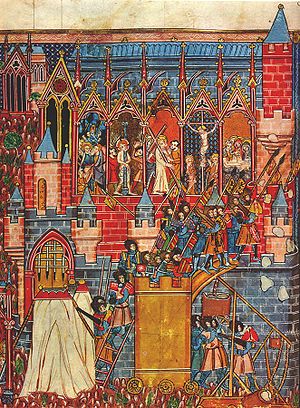The First Crusade, from 1096 – 1099, was a truly remarkable event. Tens of thousands of soldiers, pilgrims and churchmen from all across Europe, impelled by religious zeal, a search for adventure, or a desire for money, fame or glory, set out to capture Jerusalem from the Muslim. There are many facets to the story, but one of the most interesting is the rise and fall of Peter Bartholomew.

Finding the Holy Lance
In 1098 the Crusade was in crisis. It was held up at Antioch, still hundreds of miles from its target – Jerusalem. After a long and difficult siege they had captured the city, but a large Muslim army arrived almost immediately and besieged them. The Christians were starving and dying of disease. It seemed uncertain that they would be able to hold out. In this time of peril the crusaders received a message that many believed was divine interposition on their behalf. An insignificant pilgrim named Peter Bartholomew came to the leaders and reported that he had had a vision in which St. Andrew told that the Holy Lance, the spear used to pierce Jesus’s side, could be found buried at a church in Antioch.
Workmen went to the church and dug into the floor. They found nothing and were about to abandon the attempt, when Peter jumped into the hole and pulled out a spear. Most were convinced by this discovery. With the soldiers encouraged by this supposed sign from heaven, they sallied out from the city and defeated the encircling armies on June 28th.
The Ordeal by Fire
During the next months, Peter Bartholomew came to hold a place of power with the leaders of the crusade. He reported that he had many visions from St. Andrew, crusaders who had fallen in battle, and even Jesus Christ himself. He reported messages which he said they had given him, in which they gave instructions for the army and rebuked or encouraged the crusaders. Peter and the Lance were being used by Count Raymond, who was struggling with Bohemond for power.
There were those who harbored doubts. Why was it Peter who had discovered the Lance, when so many were looking for it? Why was the Lance in Antioch at all? Why was it a fanciful Arabic weapon, rather than a simple Roman spear? Finally matters came to a head. In a council of crusade leaders, Peter declared:
I wish and beg that a very large fire be built; and I will pass through the midst of it with the Lance of the Lord. If it is the Lance of the Lord, I will pass through the fire unhurt, but if it is not, I will be burned in the fire. For I see that neither signs nor witnesses are believed.1
What Peter was requesting was an ordeal of fire, a practice not unheard of during the Middle Ages. The person being tested would be exposed to either fire or red hot iron, and then they would be examined immediately, or three days later, to see if the person was either uninjured or had a wound that was healing quickly.

On April 8, 1099, two large fires were built next to each other, the flames reaching 50 feet into the air. Before a large crowd who had assembled to watch the proceeding, chaplain Raymond spoke:
If Almighty God spoke face to face with this man … let him pass through the fire unhurt. If, however, it is a falsehood, may he be burned, together with the Lance which he will carry in his hand!2
After kneeling for a moment in prayer, Peter set off through the fire, Lance in hand. He emerged on the other side living, though he did have sizable burns on his body. The ordeal was declared a success, and the multitude crowded around him, rejoicing and trying to seize a piece of his garment to keep as a relic.
The leaders had spoken too soon. Several days later, on April 20, Peter died. Some reported that he had received mortal injuries in the fire, though his remaining supporters argued that he was injured by the crowd.3
Conclusion
It is impossible to establish events of Peter Bartholomew’s life with absolute certainty, especially regarding the many visions that he professed to have seen. However, several points can be established with certainty, and they may prove applicable in evaluating other mystics.
First, Peter was a fake. If God was indeed sending him visions, he would not have allowed him to fail the test, by dying either from wounds received in the fire, or inflicted on him by the crowds. Whether he was somehow seeing visions, or he was just inventing them in his own head, they were not from God.
Second, he fully believed that he was receiving genuine visions from God. He willingly subjected himself to the ordeal of fire. If he had known he was inventing them, he would never have consented, as he would have obviously been burnt. Again, it is impossible to know with certainty what was happening in Peter’s mind. He may have really been seeing things, or perhaps he deceived so many others that he convinced himself. Either way, Peter was a fraud who was exposed at his own request.






Cool Story obviously the placebo effect kept him alive for awhile and perhaps he did see dead people after all there are plenty around.
My maternal great-grandfather was named Peter Bartholomew thus my middle name and my son bears the same middle name in his honor. Different dude but same name and a great story and probably true.
Hello cool website
Did he not die like all martyrs? If you read the stories of past “saints” they’re actions were rather paltry in comparison, even St. Ignacius of Antioch, whom died trying to get to Rome and astounding religious accomplishment is writing the pope a few letters before being killed on the way. Fraudulent or not at least he tried. Even Christ died by choice
He could’ve been authentic